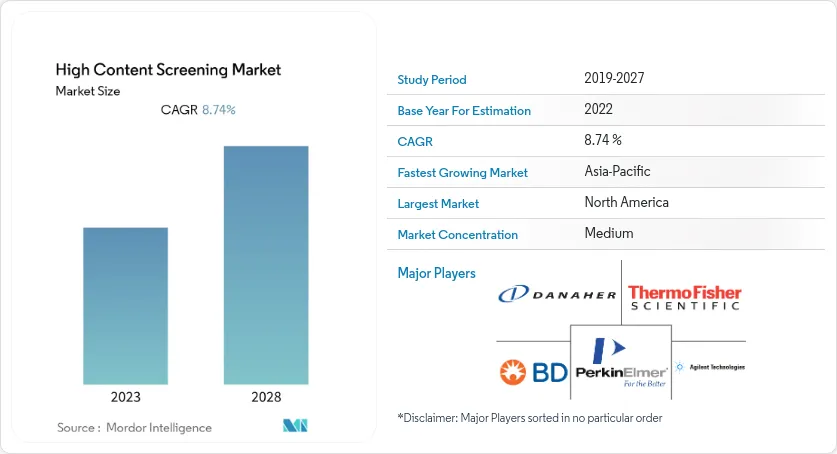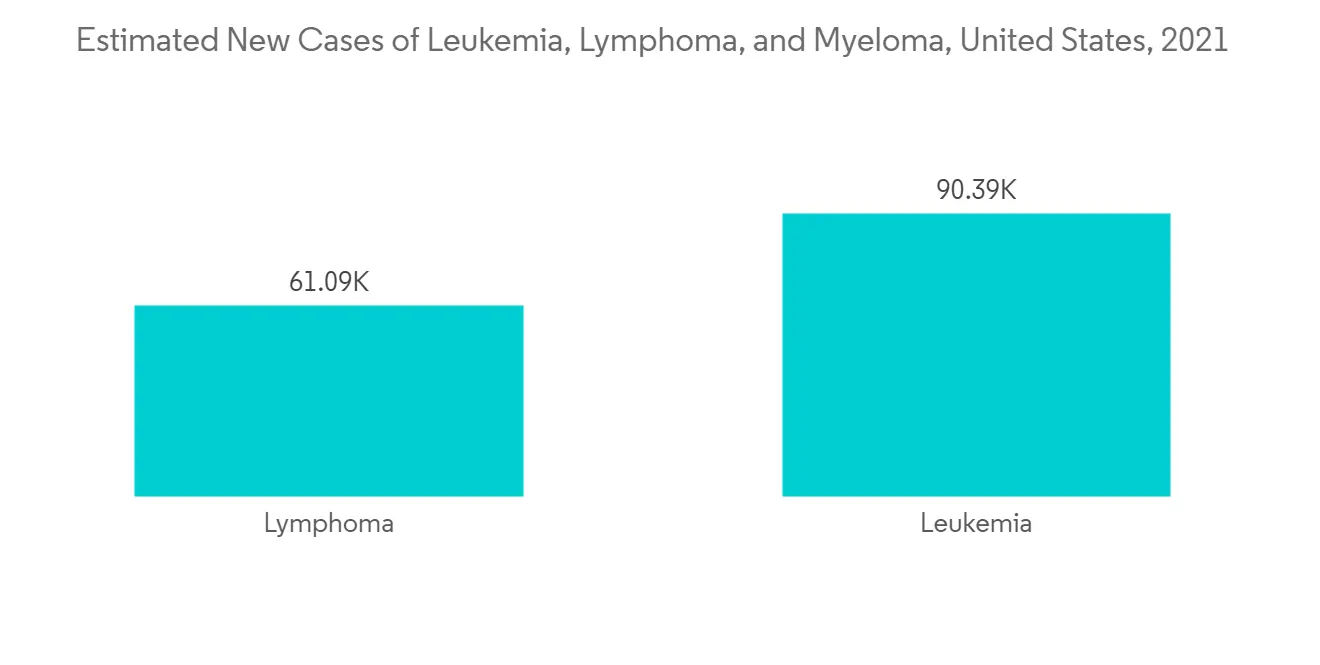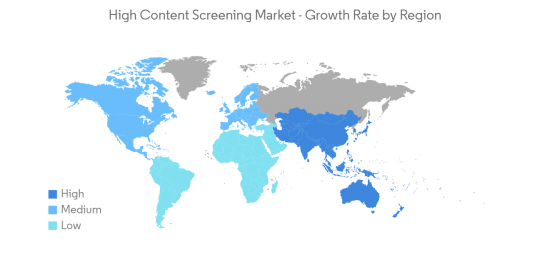 |
市場調査レポート
商品コード
1327505
ハイコンテントスクリーニング市場規模・シェア分析- 成長動向と予測(2023年~2028年)High Content Screening Market Size & Share Analysis - Growth Trends & Forecasts (2023 - 2028) |
||||||
● お客様のご希望に応じて、既存データの加工や未掲載情報(例:国別セグメント)の追加などの対応が可能です。 詳細はお問い合わせください。
| ハイコンテントスクリーニング市場規模・シェア分析- 成長動向と予測(2023年~2028年) |
|
出版日: 2023年08月10日
発行: Mordor Intelligence
ページ情報: 英文 110 Pages
納期: 2~3営業日
|
- 全表示
- 概要
- 目次

ハイコンテントスクリーニング市場は予測期間中にCAGR 8.74%で成長する見込みです。
SARS-CoV-2ウイルスに対する新規治療薬の市場開拓にほとんどのバイオ医薬品企業が従事していたため、COVID-19の発生はハイコンテントスクリーニング市場にスポットライトを当てた。創薬の増加により、特定のワクチンを市販する前にその毒性を監視・評価するための薬剤検査製品やサービスの需要が高まっていました。このため、パンデミックはハイコンテントスクリーニング市場に好影響を与えました。2020年にAmerican Chemical Society Pharmacology and Translational Scienceに掲載された研究論文によると、仮想スクリーニングと実験的スクリーニングを組み合わせた戦略で同定され、すでに承認されている薬剤の中から選択されたCOVID-19に対する新たな潜在的治療薬が、ヒドロキシクロロキン(HCQ)を参照薬とする約4000の承認薬ライブラリに対して構造的類似性をスクリーニングするために調査されました。この研究では、SARS-CoV-2感染の初期段階に対する臨床試験の候補としてズクロペンチキソール、ネビボロール、アモジアキンが、またCOVID-19治療におけるアジュバントの候補としてレムデシビルおよびファビピラビル治療薬が提案されました。このような研究のためのハイコンテントスクリーニングの使用が増加するにつれて、COVID-19は調査された市場に大きな影響を与えました。予測期間中、市場は安定した成長を示すと予想されます。
医薬品研究開発におけるコスト抑制の必要性、インフォマティクスソリューションとイメージング機器の進歩、新興国市場における政府資金とベンチャーキャピタルからの投資が、ハイコンテントスクリーニング(HCS)市場の成長を促進する主な要因です。
従来の毒性試験の方法では、潜在的な医薬品候補を探すために大規模なライブラリーをスクリーニングしています。従来の方法では、費用と資源と時間がかかり、成功率も低いです。その結果、化学物質や複雑な物質の潜在的な毒性を試験するためのハイコンテントスクリーニング(HCS)ソリューションが、時間とコストを削減することでin-vitro毒性試験を改善するために製薬会社によって採用されています。HCSのアウトソーシングサービスを提供する受託研究機関の増加や、個別化医療におけるHCSの応用は、市場に大きな成長機会をもたらしています。
市場関係者や研究者による最近の技術開発、投資の増加、世界の研究開発活動の高まりが、調査対象市場の成長に寄与しています。例えば、2021年10月、BDライフサイエンス-バイオサイエンシズは、Christian Medical College, Velloreとの提携により、インドにおける臨床研究のためのフローサイトメトリーにおける2番目のセンターオブエクセレンス(CoE)を立ち上げました。この提携により、インド全土の血液学者、医師、研究室の専門家が、臨床フローサイトメトリーにおける標準化とベストプラクティスについて討議することが可能になります。このCoEは臨床診断アプリケーションのためのナショナル・リファレンス・センターとして機能し、予測期間中にハイコンテント・スクリーニング市場を推進すると推定・予測されています。
さらに、サイトトロニクスは2022年4月、Anzu Partnersが主導し、Milad Alucozai(BoxOne Ventures)と機関投資家が参加する925万米ドルの初期シード資金を獲得しました。この資金調達により、同社は、腫瘍学、消化器病学、心臓病学、神経学など複数の分野で、細胞ベースの薬物スクリーニングのための調査実証済みデバイスを商業化することができます。同社は、薬物スクリーニングを目的とした技術的に高度な製品を市場に投入するという点で、提供する製品を拡大する可能性が高く、予測期間中にハイコンテンツスクリーニング市場を推進すると予想されます。
したがって、ヘルスケア投資の増加、主要企業による戦略的イニシアチブの増加などの要因によって、予測期間中、調査された市場は健全な成長を示すと考えられています。
ハイコンテントスクリーニング市場の動向
フローサイトメトリーは予測期間中に大きな市場シェアを占める見込み
フローサイトメトリーは多くの研究室や臨床検査室で使用されています。以前は、フローサイトメトリーは多数のサンプルを扱うのに限界があったため、かなり制限されていました。しかし、近年の細胞ベースの解析とスクリーニングの比類ない進歩により、この技術は強力なスクリーニングツールとして活用されています。
フローサイトメトリーを研究施設に導入する様々な研究が行われており、この分野の有用性を促進すると期待されています。フローサイトメトリーの主なユーザーは免疫学者や血液学者であり、彼らはフローサイトメトリーを細胞選別や分析に利用しています。例えば、2022年2月にFrontiers in Immunologyに掲載された研究は、複数の研究室で標準化された血液白血球サブセット上の表面抗原の定量的発現プロファイリングのためのフローサイトメトリー手順を開発するために実施されました。このプロセス、バイオインフォマティクスパイプライン、および改良されたフローパネルにより、新規抗体クローンを確立されたCDマーカーにベンチマークすること、およびHLDAの承認を受けたmAbクローンの発現パターンをCDマーカーにマッピングすることが可能になります。フローサイトメトリーの利点は、細胞の高速定量分析、高含量分析などであり、この技術は創薬アプリケーションにとって魅力的な技術です。フローサイトメトリーを用いた調査研究の増加とその利点は、分析期間中の同分野の成長を促進すると予想されます。
さまざまな市場プレーヤーが、フローサイトメトリー分野で先進的なソリューションを開発するために、製品の発売、提携、技術革新などの戦略的な取り組みを行っています。例えば、2022年3月、Beckman Coulter Life Sciences社は、臨床フローサイトメトリーにおける手動サンプル調製とデータ管理のボトルネックに対するCellMek SPSソリューションを発表しました。この全自動サンプル調製システム(SPS)はオンデマンド処理を提供し、ラボの能力向上を支援します。このような発売は、予測期間中のセグメント成長を促進すると予想されます。
したがって、フローサイトメトリーは、特に薬物反応をモニターするためにプライマリー細胞ベースのアッセイの導入が増加している環境において、理想的なツールとなりつつあります。創薬における表現型細胞ベースアッセイの使用の増加と薬剤反応のモニタリングの必要性は、フローサイトメトリーの成長の主な要因です。したがって、今後数年間は使用量が増加すると予想されます。さらに、がんの検出におけるフローサイトメトリーの利用は、このセグメントの成長をさらに増大させています。

北米は予測期間に大きな市場シェアを占めると予測される
北米は、製薬会社による研究開発活動の活発化、同国における慢性疾患の有病率の増加、ハイコンテントスクリーニング法の技術的進歩の増加により、ハイコンテントスクリーニング市場において予測期間中に大きな市場シェアを占めると予想されます。
米国がん協会の2022年報告書によると、米国では2022年に約1,918,030人の新規がん患者が発生すると推定されています。また、カナダがん統計の2021年11月の報告書によると、カナダ人の5人に2人が生涯にがんと診断される可能性があると推定されています。それによると、2021年には推定229,200人のカナダ人ががんと診断されると予測されています。したがって、がんの高い有病率は、製造された薬剤に最高の安全性と有効性を提供するために、地域の高含量スクリーニング市場を後押しすると予想されます。
患者の間で心血管疾患が増加していることから、遺伝性のさまざまな心血管疾患に対する効果的な治療薬の必要性と需要がさらに高まっています。例えば、米国における心不全の有病率は600万人で、総人口の1.8%に相当すると2021年に米国心臓協会が報告しています。これは米国で調査された市場成長の主な促進要因の1つになると予想されます。
したがって、がんや慢性疾患の有病率の高さが薬効を高めるためのハイコンテンツスクリーニングの需要を押し上げるなど、上記の要因のおかげで、ハイコンテンツスクリーニング市場は予測期間中に北米で大幅な成長を示すと予想されます。

ハイコンテントスクリーニング産業概要
ハイコンテントスクリーニング(HCS)の市場競争は中程度です。化合物のプロファイリング用途では、多くの製薬企業が創薬の潜在的な候補を同定するために受託研究機関と提携しています。HCS市場はもともと競争が激しいです。同市場の主要企業には、アジレント・テクノロジー、Cytiva、BD(ベクトン・ディッキンソン・アンド・カンパニー)、バイオ・ラッド・ラボラトリーズ、サーモフィッシャー・サイエンティフィックなどがあります。
その他の特典:
- エクセル形式の市場予測(ME)シート
- 3ヶ月間のアナリスト・サポート
目次
第1章 イントロダクション
- 調査の前提と市場定義
- 調査範囲
第2章 調査手法
第3章 エグゼクティブサマリー
第4章 市場力学
- 市場概要
- 市場促進要因
- 新興国市場における政府資金とベンチャーキャピタル投資
- ライフサイエンス研究におけるハイコンテントスクリーニングの用途拡大
- 情報化ソリューションとイメージングシステムの進歩
- 市場抑制要因
- 高価格によるハイコンテントスクリーニング機器の普及低下
- ポーターのファイブフォース分析
- 新規参入業者の脅威
- 買い手/消費者の交渉力
- 供給企業の交渉力
- 代替品の脅威
- 競争企業間の敵対関係の強さ
第5章 市場セグメンテーション(市場規模:百万米ドル)
- 製品別
- 機器
- 細胞イメージング・分析システム
- フローサイトメーター
- 消耗品
- 試薬およびアッセイキット
- マイクロプレート
- その他消耗品
- ソフトウェア
- サービス
- 機器
- アプリケーション別
- 一次および二次スクリーニング
- ターゲット同定およびバリデーション
- 毒性試験
- 化合物プロファイリング
- その他のアプリケーション
- エンドユーザー別
- 製薬・バイオテクノロジー企業
- 学術・政府機関
- 受託研究機関
- 地域別
- 北米
- 米国
- カナダ
- メキシコ
- 欧州
- ドイツ
- 英国
- フランス
- イタリア
- スペイン
- その他欧州
- アジア太平洋
- 中国
- 日本
- インド
- オーストラリア
- 韓国
- その他アジア太平洋地域
- 中東・アフリカ
- GCC
- 南アフリカ
- その他中東とアフリカ
- 南米
- ブラジル
- アルゼンチン
- その他南米
- 北米
第6章 競合情勢
- 企業プロファイル
- Danaher Corporation
- Perkinelmer Inc.
- Thermo Fisher Scientific Inc.
- BD(Becton, Dickinson and Company)
- Agilent Technologies
- Bio-Rad Laboratories Inc.
- Yokogawa Electric Corporation
- Merck KGaA
第7章 市場機会と今後の動向

The High-content Screening Market is poised to grow at a CAGR of 8.74% over the forecast period.
The outbreak of COVID-19 has turned the spotlight on the high-content screening market as most biopharmaceutical players were engaged in the development of novel therapeutics against the SARS-CoV-2 virus. Due to the increase in drug discovery, there was an increasing demand for drug testing products and services to monitor and evaluate the toxicity of a specific vaccine before commercializing it to the market. Due to this, the pandemic had a positive impact on the high-content screening market. According to the research article published in the American Chemical Society Pharmacology and Translational Science in 2020, new potential therapeutics for COVID-19 identified with a combined virtual and experimental screening strategy and selected from among the already approved drugs were studied to screen for structural similarity against a library of almost 4000 approved drugs with hydroxychloroquine (HCQ) as a reference drug. The study proposed zuclopenthixol, nebivolol, and amodiaquine as potential candidates for clinical trials against the early phase of the SARS-CoV-2 infection and remdesivir and favipiravir therapeutics as potential adjuvants in COVID-19 treatment. With the rising use of high-content screening for such studies, COVID-19 significantly impacted the market studied. The market is expected to show stable growth during the forecast period.
The need for cost containment in pharmaceutical research and development, advancements in informatics solutions and imaging instruments, and government funding and venture capital investments across developed markets are the major factors driving the growth of the High-Content Screening (HCS) Market.
Under the conventional method of toxicity studies, large libraries are screened in search of potential drug candidates. The traditional way is expensive, resource- and time-consuming, and it has a low success rate. Consequent High-Content Screening (HCS) solutions for testing the potential toxicity of chemicals and complex substances are being adopted by pharmaceutical companies to improve in-vitro toxicity testing by reducing the time and cost. The increasing number of contract research organizations providing HCS outsourcing services and the application of HCS in personalized medicine present significant growth opportunities in the market.
The recent technological developments by the market players and researchers, rising investments, and rising research and development activities worldwide are contributing to the growth of the studied market. For instance, in October 2021, BD Life Sciences-Biosciences launched its second Center of Excellence (CoE) in flow cytometry for clinical research in India in collaboration with Christian Medical College, Vellore. The partnership will allow hematologists, doctors, and lab professionals from all over India to deliberate and discuss standardization and best practices in clinical flow cytometry. This CoE will function as the National Reference Center for clinical diagnostics applications and is estimated to propel the High-Content Screening Market during the forecast period.
Furthermore, in April 2022, CytoTronics received USD 9.25 million in initial seed funding led by Anzu Partners, with participation from Milad Alucozai (BoxOne Ventures) and institutional investors. This funding will allow the company to commercialize its research-demonstrated devices for cell-based drug screening in multiple areas, such as oncology, gastroenterology, cardiology, and neurology. It is likely to expand its offerings in terms of bringing technologically advanced products to the market for drug screening purposes which is expected to propel the High-Content Screening Market during the forecast period.
Hence, with the factors such as rising healthcare investment, and increasing strategic initiatives by key players, it is believed that the market studied will witness healthy growth over the forecast period.
High Content Screening Market Trends
Flow Cytometry is Expected to Hold a Significant Market Share Over The Forecast Period
Flow cytometry is used in many research and clinical laboratories. Previously, flow cytometry was significantly restricted because of its limitations in handling scores of samples. However, with unparalleled advances in cell-based analysis and screening in recent years, this technique has been utilized as a powerful screening tool.
Various studies are done that deploy flow cytometry in research laboratories which are expected to propel the segment utility. Its primary users are immunologists and hematologists, who use it for cell sorting and analysis. For instance, a research study published in Frontiers in Immunology in February 2022, was conducted to develop a flow cytometric procedure for quantitative expression profiling of surface antigens on blood leukocyte subsets that are standardized across multiple research laboratories. The process, bioinformatics pipeline, and improved flow panels enable benchmarking new antibody clones to established CD markers and mapping the expression patterns of mAb clones with HLDA approval to CD markers. The advantages of flow cytometry, like the high-speed quantitative and high-content analysis of cells, make the technique an attractive technology for drug discovery applications. The rising research studies using flow cytometry and its advantages are expected to propel the segment growth during the analysis period.
Various market players are engaged in strategic initiatives such as product launches, partnerships, and innovation in technology to develop an advanced solution in the flow cytometry segment. For instance, in March 2022, Beckman Coulter Life Sciences launched the CellMek SPS solution to manual sample preparation and data management bottlenecks in clinical flow cytometry. The fully automated sample preparation system (SPS) offers on-demand processing to assist laboratories in enhancing their capabilities. Such launches are expected to propel the segment growth during the forecast period.
Therefore, flow cytometry is becoming an ideal tool, particularly in an environment where primary cell-based assays are increasingly being deployed to monitor drug responses. The increasing use of phenotypic cell-based assays in drug discovery and the need to monitor drug responses are major factors for the growth of flow cytometry. Therefore, the usage is expected to increase in the coming years. Additionally, the utilization of flow cytometry in the detection of cancer is further augmenting the growth of the segment.

North America is Expected to North America is Expected to Hold a Significant Market Share Over The Forecast Period
North America is expected to have a significant market share over the forecast period in the high-content screening market due to the growing research and development activities by pharmaceutical companies, the growing prevalence of chronic diseases in the country, and increasing technological advancements in high-content screening methods.
According to the American Cancer Society's 2022 report, about 1,918,030 new cancer cases were estimated in 2022 in the United States. Also, according to the Canadian Cancer Statistics November 2021 report, an estimated 2 in 5 Canadians were likely to be diagnosed with cancer in their lifetime. It stated that an estimated 229,200 Canadians was predicted to be diagnosed with cancer in 2021. Thus, the high prevalence of cancer is expected to boost the high-content screening market in the region for providing the best safety and efficacy to the manufactured drugs.
The increasing number of cardiovascular diseases among patients further increases the need and demand for effective therapeutics for various inherited cardiovascular conditions. For instance, the prevalence rate of heart failure in the United States is 6 million, which is 1.8% of its total population, as reported by the American Heart Association in 2021. This is expected to be one of the major driving factors for the growth of the market studied in the United States.
Therefore, owing to the factors mentioned above, such as the high prevalence of cancer and chronic diseases boosting the demand for high-content screening for boosting drug efficacy, the high-content screening market is expected to witness substantial growth in North America during the forecast period.

High Content Screening Industry Overview
The Market for High Content Screening (HCS) is moderately competitive. For compound profiling applications, many pharmaceutical companies are partnering with contract research organizations to identify potential candidates for drug discovery. The HCS market is highly competitive in nature. Some of the key companies in the market are Agilent Technologies, Cytiva, BD (Becton, Dickinson and Company), Bio-rad Laboratories, and Thermofisher Scientific, among others.
Additional Benefits:
- The market estimate (ME) sheet in Excel format
- 3 months of analyst support
TABLE OF CONTENTS
1 INTRODUCTION
- 1.1 Study Assumptions and Market Definition
- 1.2 Scope of the Study
2 RESEARCH METHODOLOGY
3 EXECUTIVE SUMMARY
4 MARKET DYNAMICS
- 4.1 Market Overview
- 4.2 Market Drivers
- 4.2.1 Government Funding and Venture Capital Investments Across Developed Markets
- 4.2.2 Increasing Applications of High Content Screening in Life Science Research
- 4.2.3 Advancements in Informatic Solutions and Imaging Systems
- 4.3 Market Restraints
- 4.3.1 Lower Adoption of High Content Screening Instruments Due to Their High Prices
- 4.4 Porter's Five Forces Analysis
- 4.4.1 Threat of New Entrants
- 4.4.2 Bargaining Power of Buyers/Consumers
- 4.4.3 Bargaining Power of Suppliers
- 4.4.4 Threat of Substitute Products
- 4.4.5 Intensity of Competitive Rivalry
5 MARKET SEGMENTATION (Market Size by Value - USD million)
- 5.1 By Product
- 5.1.1 Instruments
- 5.1.1.1 Cell Imaging and Analysis Systems
- 5.1.1.2 Flow Cytometers
- 5.1.2 Consumables
- 5.1.2.1 Reagents and Assay Kits
- 5.1.2.2 Microplates
- 5.1.2.3 Other Consumables
- 5.1.3 Software
- 5.1.4 Services
- 5.1.1 Instruments
- 5.2 By Application
- 5.2.1 Primary and Secondary Screening
- 5.2.2 Target Identification and Validation
- 5.2.3 Toxicity Studies
- 5.2.4 Compound Profiling
- 5.2.5 Other Applications
- 5.3 By End User
- 5.3.1 Pharmaceutical and Biotechnology Companies
- 5.3.2 Academic and Government Institutions
- 5.3.3 Contract Research Organization
- 5.4 Geography
- 5.4.1 North America
- 5.4.1.1 United States
- 5.4.1.2 Canada
- 5.4.1.3 Mexico
- 5.4.2 Europe
- 5.4.2.1 Germany
- 5.4.2.2 United Kingdom
- 5.4.2.3 France
- 5.4.2.4 Italy
- 5.4.2.5 Spain
- 5.4.2.6 Rest of Europe
- 5.4.3 Asia-Pacific
- 5.4.3.1 China
- 5.4.3.2 Japan
- 5.4.3.3 India
- 5.4.3.4 Australia
- 5.4.3.5 South Korea
- 5.4.3.6 Rest of Asia-Pacific
- 5.4.4 Middle East and Africa
- 5.4.4.1 GCC
- 5.4.4.2 South Africa
- 5.4.4.3 Rest of Middle East and Africa
- 5.4.5 South America
- 5.4.5.1 Brazil
- 5.4.5.2 Argentina
- 5.4.5.3 Rest of South America
- 5.4.1 North America
6 COMPETITIVE LANDSCAPE
- 6.1 Company Profiles
- 6.1.1 Danaher Corporation
- 6.1.2 Perkinelmer Inc.
- 6.1.3 Thermo Fisher Scientific Inc.
- 6.1.4 BD (Becton, Dickinson and Company)
- 6.1.5 Agilent Technologies
- 6.1.6 Bio-Rad Laboratories Inc.
- 6.1.7 Yokogawa Electric Corporation
- 6.1.8 Merck KGaA
